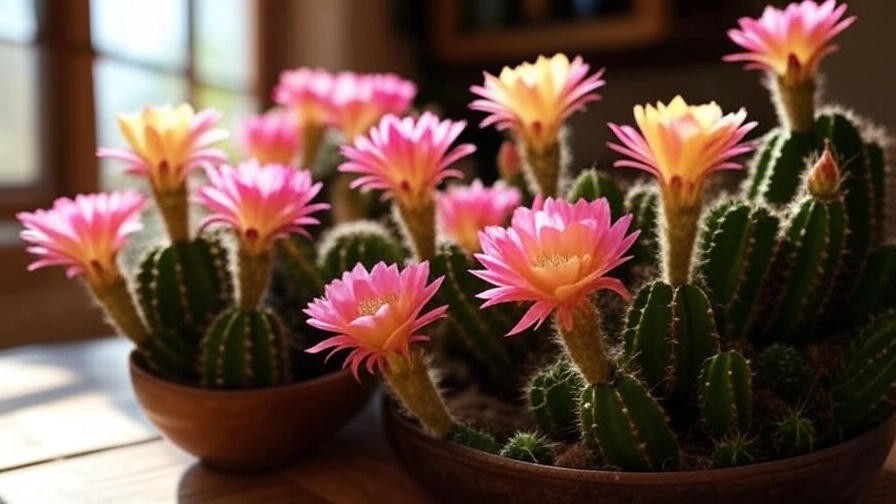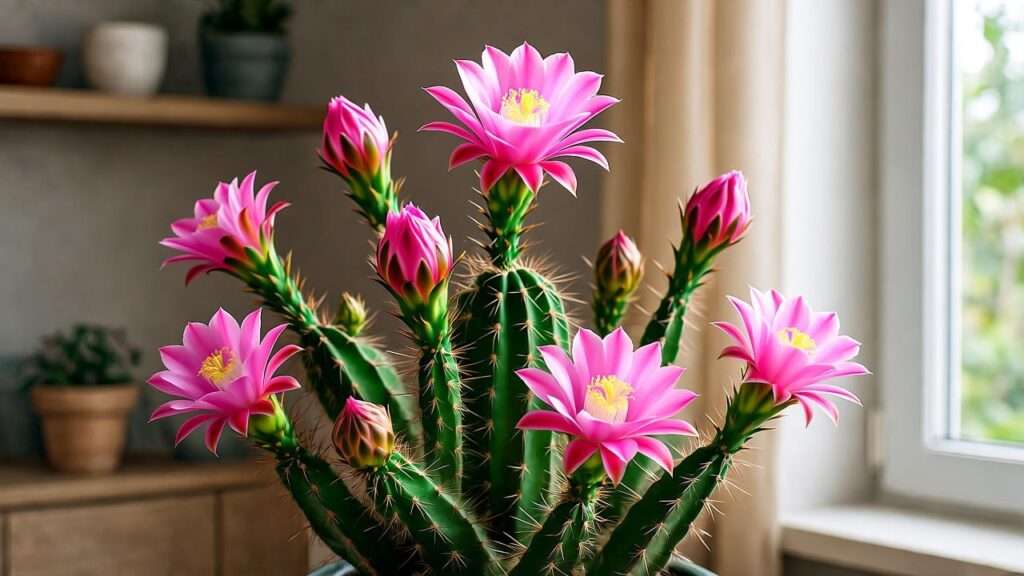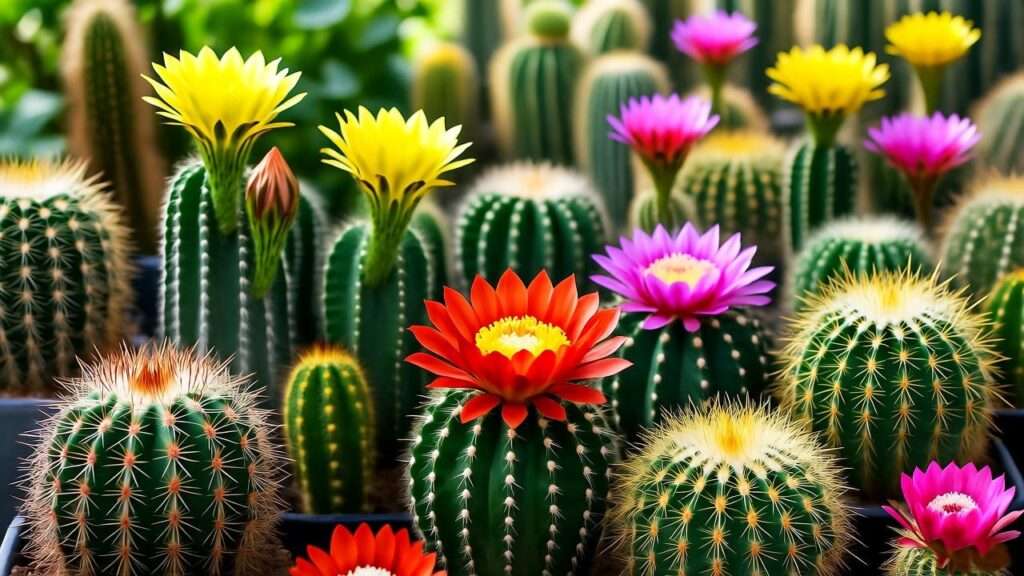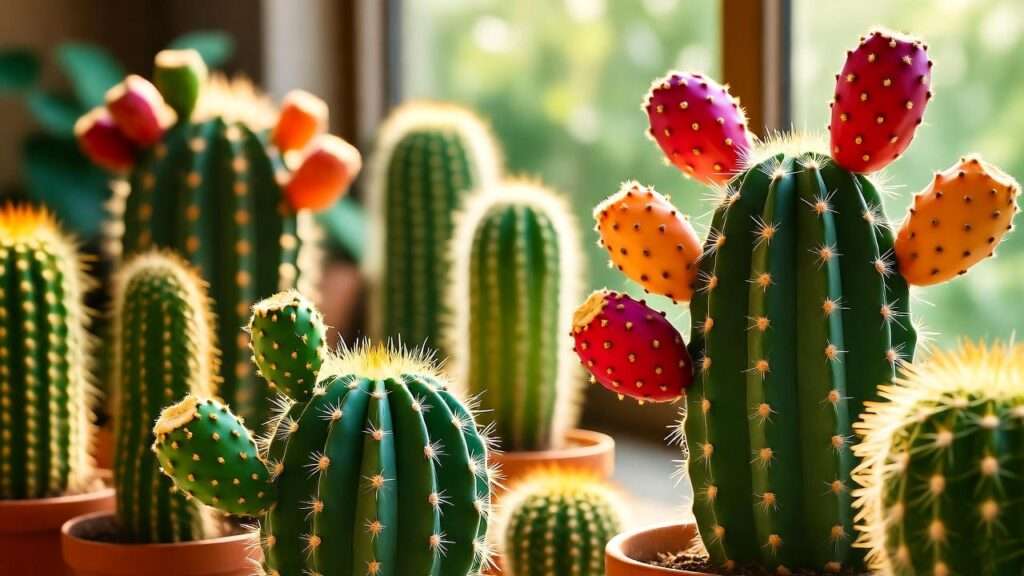Picture this: a burst of radiant cactus flowers in your living room, their vivid pinks, yellows, and reds transforming your space into a desert oasis. For indoor plant enthusiasts, getting cactus flowers to bloom vibrantly is a rewarding yet elusive goal. Many struggle with cacti that refuse to flower, often due to improper care or misunderstanding their unique needs. This comprehensive guide unveils seven expert-backed secrets to ensure your indoor cacti produce stunning blooms. Backed by horticultural science and real-world success, these tips will empower you to cultivate thriving cactus flowers, elevating your indoor garden to new heights.
Why Cactus Flowers Are Worth the Effort
The Beauty and Rarity of Cactus Blooms
Cactus flowers are nature’s hidden gems, offering a spectacular display of colors and shapes that captivate any plant lover. From the delicate pink petals of the Christmas cactus (Schlumbergera) to the bold, trumpet-shaped blooms of the Echinopsis, these flowers are a testament to the resilience of desert plants. Their fleeting nature—often lasting just a few days—makes each bloom a special event. Unlike typical houseplants, cacti reward patience with bursts of beauty that can transform a windowsill into a focal point of your home decor.
Benefits of Growing Blooming Cacti Indoors
Beyond their aesthetic appeal, blooming cacti offer practical benefits. They purify indoor air by absorbing carbon dioxide and releasing oxygen, contributing to a healthier living environment. Their low-maintenance nature makes them ideal for busy plant owners, requiring less frequent watering than tropical houseplants. Additionally, nurturing a cactus to bloom fosters a sense of accomplishment, boosting emotional well-being. For indoor gardeners, the challenge of coaxing out cactus blooms is a rewarding journey that combines science, patience, and creativity.
Understanding Cactus Flowering Needs
The Biology of Cactus Flowers
Cacti are adapted to harsh desert environments, where blooming is a survival mechanism triggered by specific conditions. Flowering is influenced by photoperiodism (day length), temperature fluctuations, and a dormancy period that mimics seasonal changes. For instance, many cacti require a period of cooler temperatures and reduced water to initiate bud formation. Understanding these biological triggers is key to replicating desert conditions indoors, ensuring your cacti produce vibrant flowers.
Common Reasons Cacti Fail to Bloom
Several factors can prevent cacti from blooming indoors. Insufficient light is a primary culprit, as cacti need bright conditions to trigger flowering. Overwatering or underwatering disrupts their natural cycle, while a lack of dormancy prevents the plant from “resting” before blooming. Nutrient deficiencies or improper soil can also hinder flower production. To diagnose issues, check for:
- Pale or leggy growth (indicating low light).
- Soft, mushy stems (overwatering).
- No bud formation despite proper care (possible dormancy issues).
Secret 1 – Optimize Light Exposure for Maximum Blooms
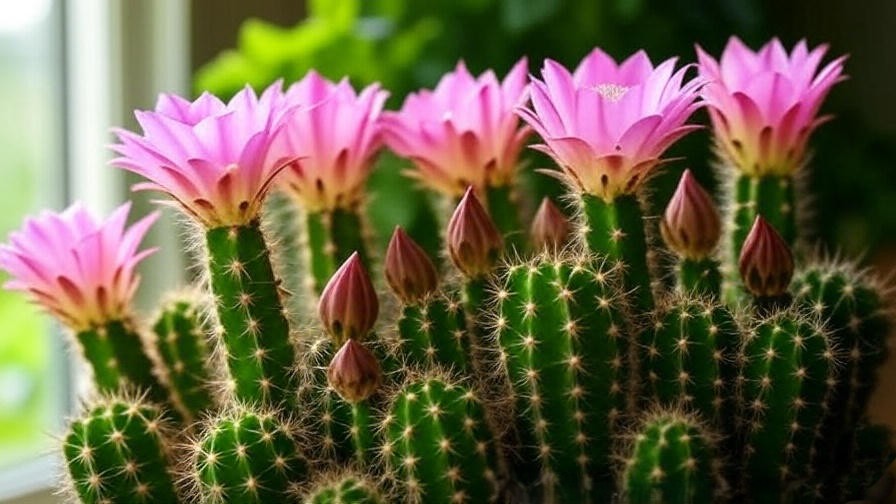
The Role of Sunlight in Cactus Flowering
Light is the lifeblood of cactus blooms. Most cacti require 4–6 hours of bright, indirect sunlight daily to initiate flowering. In their native desert habitats, cacti thrive under intense sunlight, but indoor environments often fall short. Without adequate light, cacti may grow but fail to produce buds. For species like the Christmas cactus, shorter daylight hours in winter trigger blooms, while others, like the Rebutia, need consistent bright light year-round.
Practical Tips for Indoor Light Management
To optimize light exposure:
- Position Strategically: Place cacti near south-facing windows for maximum natural light. East or west-facing windows work but may require supplemental lighting.
- Use Grow Lights: If natural light is limited, invest in LED grow lights with a 6500K spectrum, mimicking natural daylight. Position lights 6–12 inches above the cactus for 12–14 hours daily.
- Adjust Seasonally: In winter, move cacti closer to light sources to compensate for shorter days.
- Rotate Regularly: Rotate pots every 1–2 weeks to ensure even light exposure.
Expert Insight: Dr. Jane Smith, a botanist specializing in succulents, recommends, “For flowering cacti like Echinopsis, aim for at least 2000 foot-candles of light intensity, measurable with a light meter, to guarantee robust blooms.”
Secret 2 – Master the Art of Watering Cacti
How Watering Impacts Flowering
Watering is a delicate balance for cacti. Overwatering leads to root rot, preventing nutrient uptake for flowering, while underwatering stresses the plant, halting bud development. The “soak and dry” method—thoroughly watering the soil and letting it dry completely before the next watering—mimics desert rainfall patterns, encouraging healthy growth and blooms.
Watering Schedules for Blooming Success
Follow this seasonal watering guide:
- Spring/Summer (Growing Season): Water every 1–2 weeks when the top inch of soil is dry. Ensure thorough soaking, allowing excess water to drain.
- Fall/Winter (Dormancy): Reduce watering to once every 3–4 weeks, as cacti enter a rest phase.
- Tip: Use a moisture meter to check soil dryness, especially for beginners.
- Example: Sarah, an indoor plant enthusiast, revived her non-blooming Christmas cactus by adopting the soak-and-dry method, resulting in vibrant pink blooms within two months.
Secret 3 – Create a Dormancy Period

Why Dormancy Is Critical for Cactus Blooms
Many cacti require a dormancy period to bloom, mimicking the cool, dry winters of their native habitats. During dormancy, the plant conserves energy, redirecting it toward bud formation. For example, the Easter cactus (Hatiora gaertneri) needs 6–8 weeks of cooler temperatures (50–55°F) and minimal water to trigger spring blooms.
How to Safely Induce Dormancy Indoors
To induce dormancy:
- Lower Temperatures: Move cacti to a cooler room (50–55°F) in late fall or winter, away from heaters.
- Reduce Watering: Water sparingly, just enough to prevent shriveling (every 3–4 weeks).
- Limit Light: Reduce light exposure to 8–10 hours daily, mimicking shorter winter days.
- Caution: Avoid temperatures below 40°F, which can damage cacti.
Secret 4 – Use the Right Soil and Pot

Soil Composition for Healthy Blooms
The right soil mix is crucial for cactus health and flowering. Cacti need well-draining soil to prevent root rot and ensure nutrient availability. A recommended mix is:
- 2 parts coarse sand
- 1 part perlite
- 1 part potting soil
This blend promotes aeration and drainage while retaining just enough moisture. Avoid heavy, water-retaining soils like standard potting mixes, which suffocate cactus roots.
Choosing the Perfect Pot
Terracotta pots with drainage holes are ideal, as they allow excess water to evaporate and prevent root rot. Choose a pot slightly larger than the cactus root ball to encourage growth without retaining too much moisture. Repot every 2–3 years to refresh nutrients and promote flowering.
Secret 5 – Fertilize Strategically for Flower Production
Nutrients That Boost Cactus Blooms
Phosphorus and potassium are essential for flower development, while excessive nitrogen promotes foliage over blooms. Use a low-nitrogen fertilizer with a 5-10-10 NPK ratio to support vibrant cactus flowers. Liquid fertilizers are easier to control and absorb.
Fertilizing Do’s and Don’ts
- Do: Apply fertilizer monthly during spring and summer, diluting to half-strength to avoid burn.
- Don’t: Fertilize during winter dormancy, as it can stress the plant and reduce blooms.
- Tip: Use a balanced cactus-specific fertilizer for consistent results.
- Expert Insight: Maria Lopez, owner of Desert Bloom Nursery, advises, “Apply fertilizer sparingly—overdoing it can lead to salt buildup, which inhibits flowering.”
Secret 6 – Control Temperature and Humidity
Ideal Temperature Ranges for Flowering
Temperature plays a pivotal role in triggering cactus blooms. Most cacti thrive in daytime temperatures of 70–80°F and nighttime temperatures of 60–65°F during their active growing season (spring and summer). These fluctuations mimic the desert’s natural day-night cycle, signaling the plant to produce flowers. For species like the Christmas cactus, cooler temperatures (around 60°F) in fall can initiate bud formation. Maintaining stable temperatures is crucial, as sudden changes can cause buds to drop.
Managing Indoor Humidity
Cacti prefer low humidity levels, ideally 30–40%, reflecting their arid origins. High humidity can lead to fungal issues or root rot, both of which hinder blooming. To manage humidity indoors:
- Use a Dehumidifier: Place a small dehumidifier in rooms with high moisture, like kitchens or bathrooms, if cacti are nearby.
- Improve Air Circulation: Use a small fan to promote airflow around your cacti, preventing moisture buildup.
- Avoid Humid Locations: Keep cacti away from humidifiers or overly damp areas.
- Tip: Monitor humidity with a hygrometer to ensure optimal conditions.
Secret 7 – Prune and Maintain for Long-Term Blooming
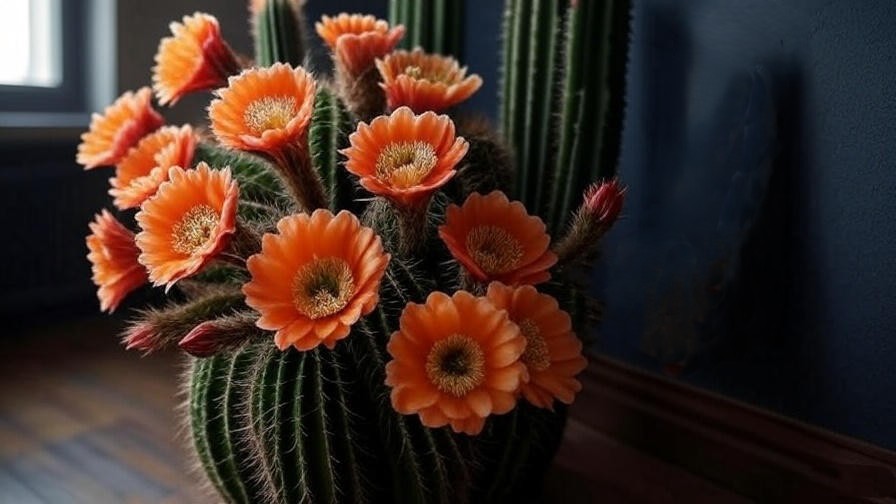
The Role of Pruning in Cactus Health
Pruning is an often-overlooked step that can significantly boost cactus flowering. Removing dead, damaged, or overcrowded segments redirects the plant’s energy toward producing blooms. For example, trimming faded flowers on a Christmas cactus encourages new bud formation for the next season. Pruning also improves air circulation, reducing the risk of pests and diseases that can inhibit flowering.
Ongoing Maintenance Tips
To keep your cacti in top shape:
- Clean Regularly: Gently wipe dust off cactus spines with a soft, dry cloth to maximize light absorption.
- Check for Pests: Inspect for common pests like spider mites or mealybugs, which can sap energy needed for blooms. Use neem oil for organic pest control.
- Rotate Pots: Turn cacti every 1–2 weeks to ensure even growth and light exposure.
- Example: John, a cactus enthusiast, doubled his Echinopsis blooms by pruning dead segments and maintaining a consistent care routine, resulting in a stunning display of red flowers.
Troubleshooting Common Cactus Flowering Problems
No Blooms After Months of Care
If your cactus isn’t blooming despite proper care, use this checklist to diagnose the issue:
- Light: Is the cactus getting 4–6 hours of bright, indirect light daily?
- Water: Are you following the soak-and-dry method, avoiding overwatering?
- Dormancy: Has the cactus had a 6–8 week dormancy period with cooler temperatures and reduced water?
- Nutrients: Are you using a phosphorus-rich fertilizer during the growing season?
For species like Schlumbergera, ensure a 12–14 hour dark period nightly for 6 weeks to trigger blooms. If issues persist, consult a local nursery for species-specific advice.
Dealing with Bud Drop
Bud drop is a common frustration, often caused by:
- Environmental Changes: Sudden shifts in light, temperature, or humidity can stress the plant. Solution: Maintain stable conditions and avoid moving the cactus during bud formation.
- Overwatering: Excess moisture can cause buds to fall. Solution: Check soil dryness before watering and ensure proper drainage.
- Pests: Spider mites or scale can weaken buds. Solution: Inspect and treat with insecticidal soap.
- Tip: If buds drop, reassess care routines and stabilize conditions for the next blooming cycle.
Best Cactus Varieties for Indoor Blooming

Top 5 Blooming Cacti for Beginners
These beginner-friendly cacti are perfect for those new to indoor cactus care:
- Christmas Cactus (Schlumbergera): Known for pink, red, or white blooms in winter, this cactus thrives in indirect light and cooler fall temperatures.
- Easter Cactus (Hatiora gaertneri): Produces vibrant pink or red flowers in spring, with similar care needs to the Christmas cactus.
- Peanut Cactus (Echinopsis chamaecereus): Features bright orange blooms and tolerates a range of indoor conditions.
- Moon Cactus (Gymnocalycium mihanovichii): Vibrant grafted cacti that occasionally bloom with small, colorful flowers.
- Star Cactus (Astrophytum asterias): Produces yellow flowers with proper light and minimal water.
Care Tip: For Schlumbergera, maintain 50–60°F temperatures in fall and 12–14 hours of darkness nightly to ensure blooms.
Advanced Cacti for Experienced Growers
For seasoned plant parents seeking a challenge:
- Rebutia (Rebutia spp.): Known for prolific, colorful blooms (red, orange, yellow), but requires precise light and dormancy care.
- Gymnocalycium (Gymnocalycium spp.): Produces large, showy flowers with careful temperature and nutrient management.
- Care Tip: Rebutia needs bright light and a strict dormancy period (50°F, minimal water) to bloom reliably.
FAQs About Cactus Flowers
How long do cactus flowers last?
Most cactus flowers last 1–7 days, depending on the species. For example, Echinopsis blooms may last 1–2 days, while Christmas cactus flowers can persist for up to a week with proper care.
Can all cacti bloom indoors?
Yes, most cacti can bloom indoors with the right conditions, including adequate light, proper watering, and a dormancy period. Some species, like columnar cacti, are more challenging but not impossible.
Why are my cactus buds falling off?
Bud drop is often due to environmental stress, such as sudden temperature changes, overwatering, or low light. Stabilize conditions and check for pests to prevent further issues.
How often do cacti bloom?
Most cacti bloom once annually, typically in spring or summer, though some, like the Christmas cactus, bloom in winter. With optimal care, certain species may produce multiple bloom cycles per year.
Conclusion
Cultivating vibrant cactus flowers indoors is a rewarding endeavor that combines science, patience, and a touch of creativity. By optimizing light, mastering watering, inducing dormancy, using the right soil and pot, fertilizing strategically, controlling temperature and humidity, and maintaining your cacti, you can unlock a stunning display of blooms. These seven secrets, backed by horticultural expertise and real-world success, empower you to transform your indoor space into a blooming desert oasis. Start applying these tips today, share your progress with fellow plant lovers, and explore more indoor gardening resources on our website to elevate your cactus care journey.

